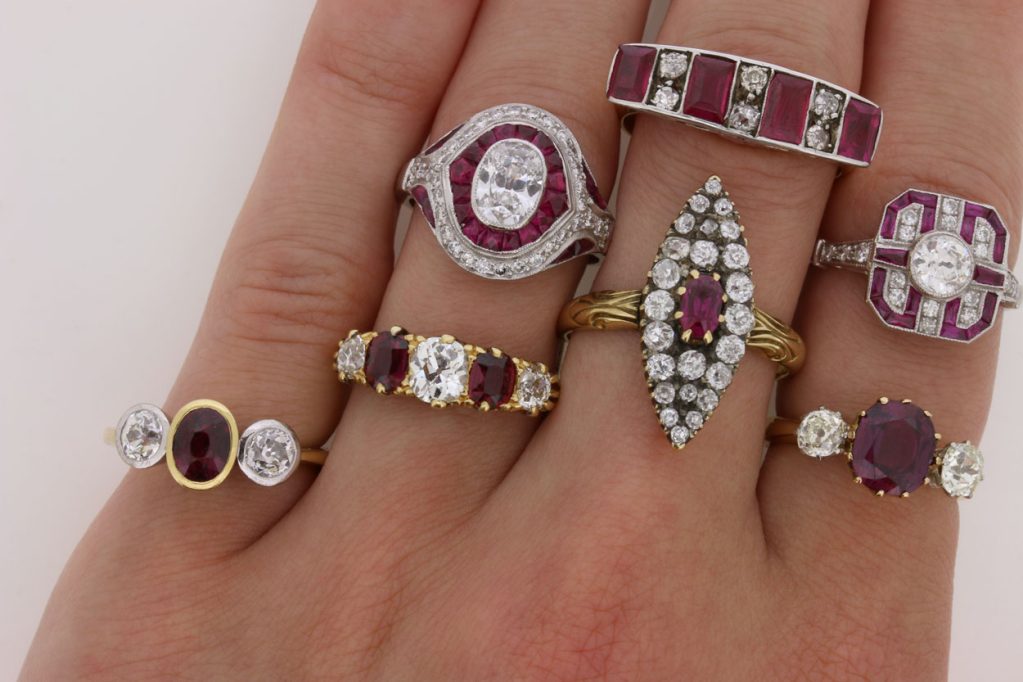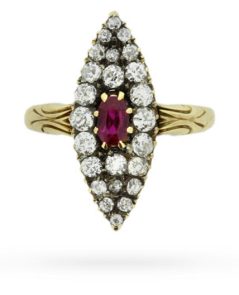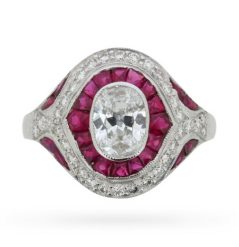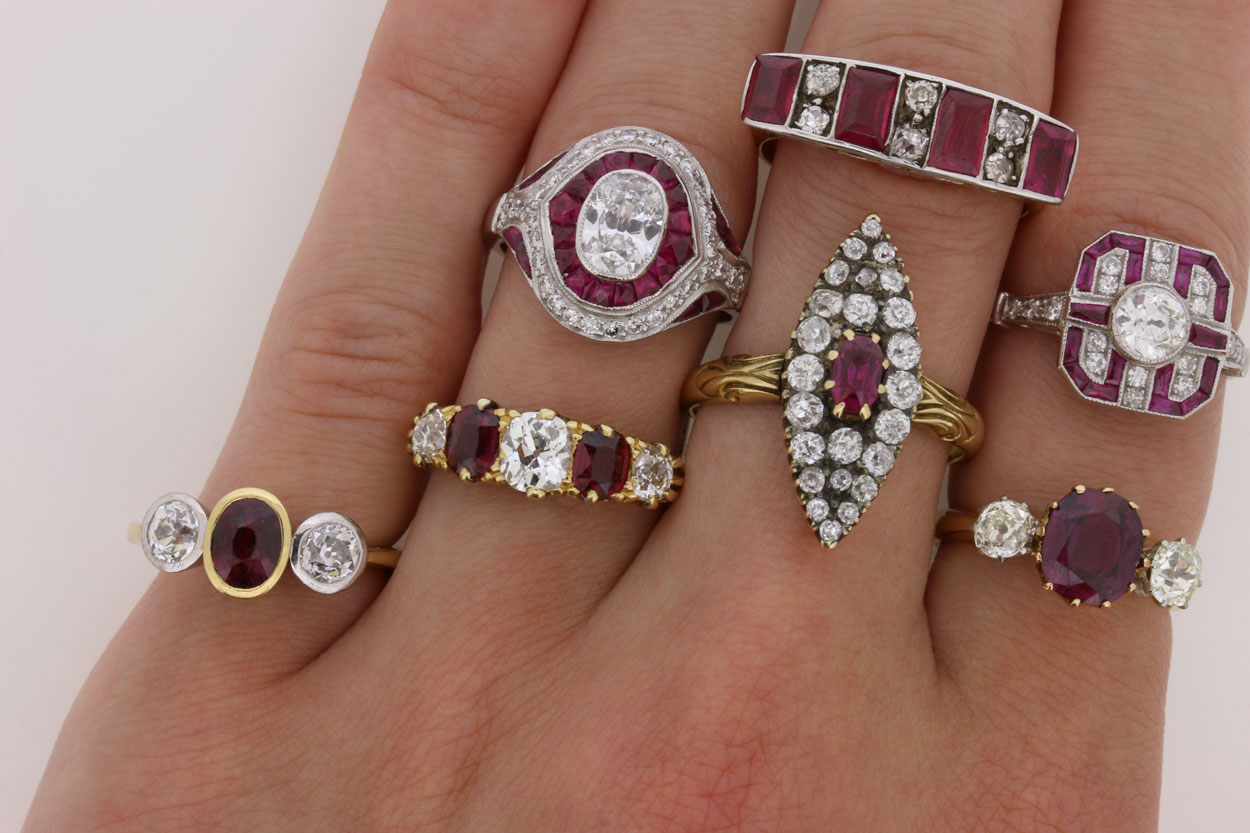
Everyone recognises the Ruby and as one of the most popular gemstones across the globe. However, with a large number of stones coming onto the market which bear close resemblance to the Ruby, how do you identify one from the other? We will reveal the fraudsters from the real deals, and give you some key takeaways for when you are shopping.

The only natural gemstones harder than a Ruby is the Diamond, which is part of the appeal. This is on par with a Sapphire, given both stones are made from the same mineral, Corundum. The difference, being the colour, is down to the presence of other isotopes in the stone, such as iron, titanium or chromium.
The History of the Ruby
The name Ruby originates from the Latin word ruber, meaing red. Rubies have been considered one of the most precious stones throughout their history, which began in 600AD after they were discovered and mined in Burma (now Myanmar). This being said, there are records in literature which date back to 200BC which state rubies being transported throughout China. Myanmar has remained the most popular mining spot for Rubies, and they have been historically mined in Thailand, India and even Scotland. Post the second world war, they were also discovered in Madagascar and Vietnam. Burmese Rubies remain the most popular on the market, as their quality is excellent.

Rubies are recognised for their vibrant colour, which is the most important factor when it comes to purchasing or valuing a stone. The colour is determined using three key factors; tone, hue and saturation. Hue is highly significant. Ruby is defined to be red, whereas all other hues of the gem species are Sapphires. See our previous blog piece on Sapphires to learn more.
Rarely is the hue pure red, so gemmologists will look at secondary hues. The primary colour in Rubies is red, while the secondary can be pink, orange or purple, with purple being the preferred option. The most popular colour is a vivid dark-medium toned red for a ruby.

In order to reach this preferred standard, rubies are frequently treated or enhanced by heating with the presence of a chemical flux. Heat improves the colour by removing the purple tinge and silk from the gem. The other treatment, which has become more frequent of recent, is lead glass filling. The process involves filling fractures on the ruby with lead glass, dramatically improving the transparency of the stone. It also means that ruby is more stable, so can be used in jewellery more effectively. Any treatment devalues the stone dramatically.
A trained jeweller will be able to identify a treated ruby, and most will be certified to state whether they are or not. Don’t be afraid to ask when purchasing, and if the price seems oddly low, then the likelihood is the ruby is treated!
The Imposters
When shopping for rubies, you don’t just have to be fearful of treated stones, but also the synthetic and imitation rubies. With the high price of natural rubies, many consumers are becoming more interested in the synthetic ruby, which was invented in 1837. There are several processes to make synthetic rubies, with flame fusion being most popular. The other alternative is to buy an imitation ruby, which is a different gem with a very similar look, such as a spinel or garnet. The key questions for consumers though, is how to identify a real ruby from a synthetic, or an imposter.
Synthetic Rubies
These rubies are created through an artificial process, as mentioned above. In terms of the chemical makeup of a synthetic ruby, they are no different from natural ones and will still be considered real rubies. This means they are not the same as fake rubies, which have a different chemical structure. Based on this, it can be tricky to spot the differences between a natural and a synthetic ruby. There are some subtle differences which can be detected with the appropriate equipment.
- Clues within the structure of the stone. Under a microscope, gemmologists are able to see the “growth lines” of the ruby. These occur during the formation of the stone; however artificial ones differ from natural ones because they are curved. There may also be microscope gas bubbles which have been created in the manufacturing process.
- The smallest of differences in chemicals. Although labs are becoming more and more sophisticated and are able to create synthetic rubies almost identical to natural rubies, there are some slight chemical differences. Synthetic rubies tend to have tiny amounts of lead, which indicates it is lab grown.
- If you are unable to have the ruby tested, there are a few signs you can watch out for, which may suggest it is a synthetic ruby. Synthetics tend to have perfect clarity, because they are made through a controlled process. Size is also a factor. Big natural rubies are very rare, so if you see a ruby over 1.5 carat, there is a high possibility of it being synthetic. Finally, the price is significantly different. Synthetic rubies sit with a price tag in-between natural and fake stones. A fake ruby can cost 90% less than a natural, whereas a synthetic will cost 15% less.
If you are unsure, then ask the person selling. Remember to as for a certificate as well, which will state to origin.
Imitation rubies
Imitation rubies are other types of gem stones which have been marketed, or falsely sold as rubies. It can be a simple mistake, or a deliberate effort to misguide customers. Here are a few gem stones which are often mistaken for rubies.
- Spinel; Often referred to as Balas Rubies, Spinel’s are a much softer stone and a duller shade of red to natural rubies. Spinel’s can also come in a variety of colours, including pink, blue, lavender and dark green. However, this does not mean it is easier to differentiate between the two. Most of the time, it comes down to the hardness of the stone, and the how light is refracted. A ruby is doubly refractive, while a spinel is singly refractive.
- Garnets; Alongside a large difference in price tags, garnets different from rubies in hardness and their red colour. Garnets have a much stronger hint of orange or brown. They tend to look earthier. Rubies on the other hand have a vivid redness.
- Glass; Lots of so called rubies on the market, actually turn out to be red glass – which would be highly frustrating if you had just paid ruby prices. These are not very durable, and should be obvious to most as not real. Compare the stone to a piece of red glass if you are unsure and the differences (or similarities) will become evident.
- Rubellite (tourmalines); The difference between these and a ruby is down to the structure and again, intensity of colour. Rubellites are seen as a cheap alternative to rubies, given the have a very similar deep, rich colour. They are actually considered to be rarer than rubies, however, do not have the same density as rubies and just like the garnet and spinel, are not as hard.
To ensure you are not marketed false rubies, ask for the certificate or even ask what it means on the Mohs Scale (measures hardness, rubies are 9, second in command to diamonds.) Ask a qualified jeweller and question the price. We have a great selection of rubies, which can be found on our website, or in our shop front in Hatton Garden.
We would love to hear your thoughts and experiences, so get in touch!





